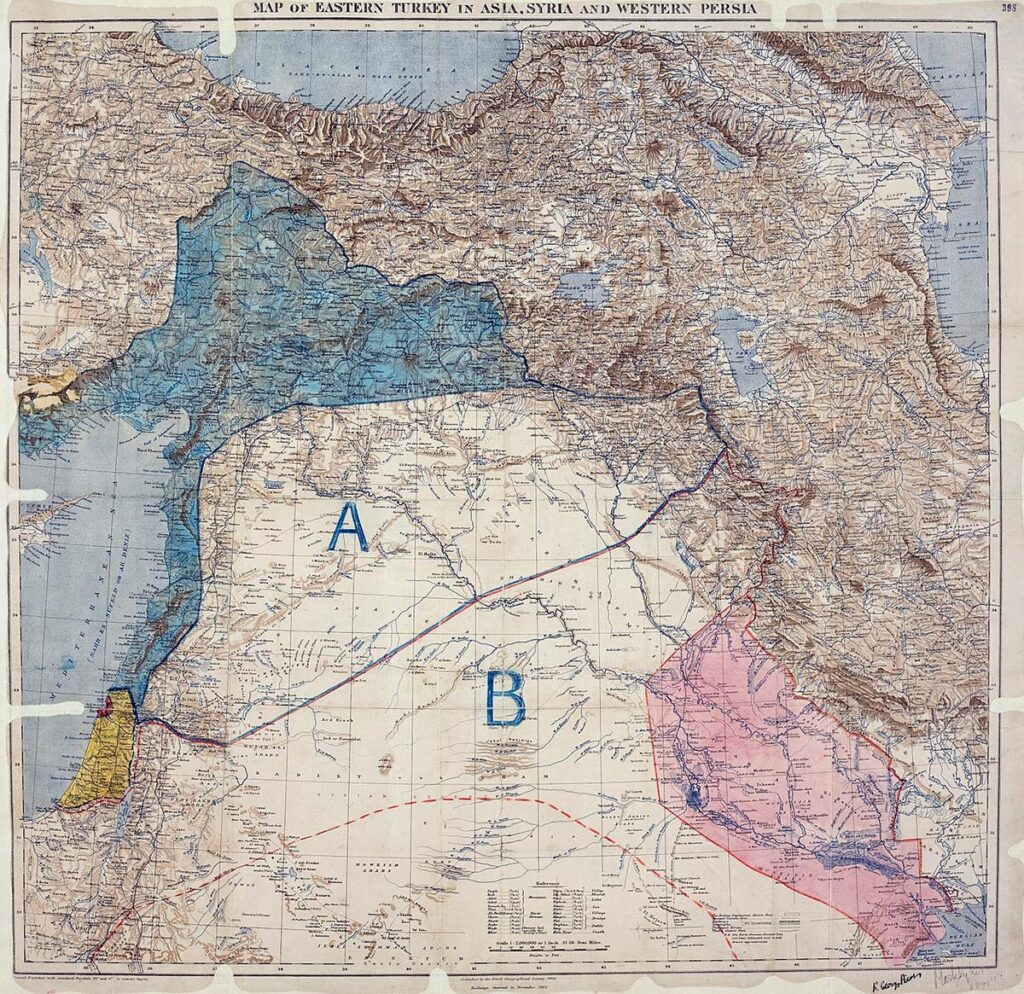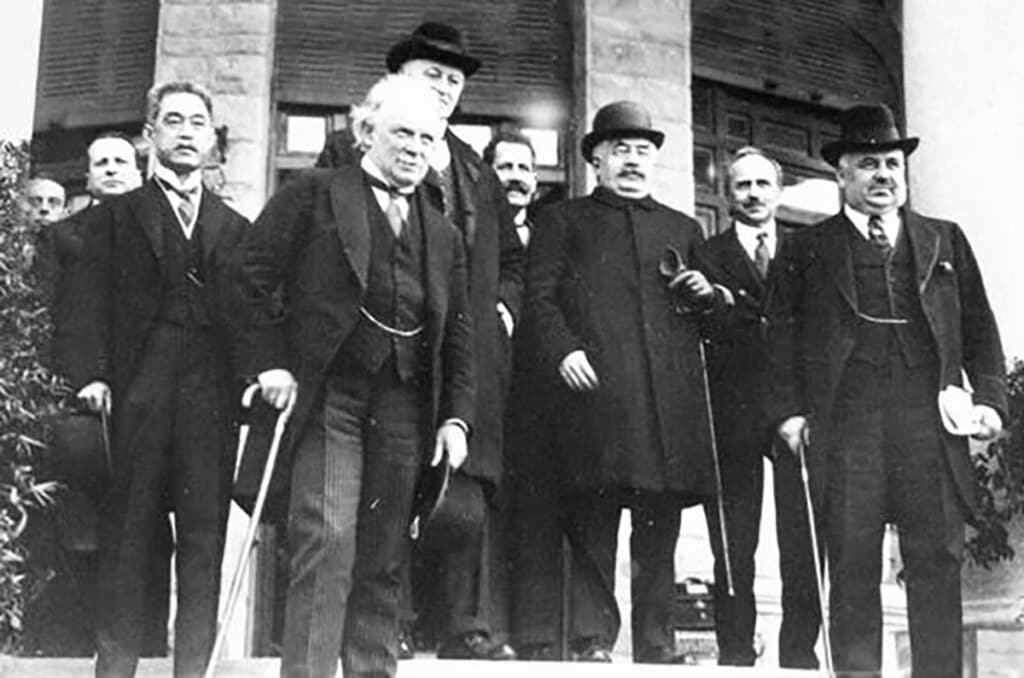You’ve probably heard of ISIS, the fundamentalist terror group best known for human rights atrocities. ISIS hates a lot of stuff: modernity, Shia Islam, women, and…the Sykes-Picot Agreement of 1916.
ISIS is kind of obsessed with destroying a fairly obscure secret agreement from the WWI era. They even released a whole 2014 propaganda video called “The End of Sykes-Picot.”
What exactly is Sykes-Picot and why is ISIS so up in arms about this random and seemingly inconsequential piece of history?
During WWI, as the Allies — France, Britain, Russia, Italy, Japan, and America — duked it out against Germany, the Austro-Hungarian Empire, and the Ottoman Empire, the Ottoman Empire in particular had been declining for a while. It was even called “the sick man of Europe.”
The Ottoman Empire controlled the modern states of Turkey, Syria, Lebanon, Israel, Iraq, and parts of Saudi Arabia. It was a very resource-rich territory with strategic port access. Everyone wanted a piece of that pie. So Britain and France — who were allied against the Ottomans — started drawing up wish lists for how to divvy up those juicy Ottoman lands. Britain sent Sir Mark Sykes to negotiate with François Marie Denis Georges-Picot.
Together, these two minor diplomats sliced up the Middle East and handed out the pieces. For Russia, a part of Turkey. For France, another part of Turkey, southern Lebanon, and most of Syria. And for jolly old England: Iraq, Jordan, the Negev, and the Sinai.
What about the Holy Land?
Understatement of the century: the Holy Land is contentious. Its religious significance alone made it a significant prize. So Sykes and Picot compromised: Most of Palestine, as it was called then, would be an international zone under British, French, and Russian “protection.” Meaning, the land would be controlled by everyone…except the people who actually lived there.
When the world found out about Britain and France’s wheeling and dealing, everyone was peeved, the Zionist movement in particular. Why? In 1917, Britain had promised “a national home for the Jewish people” in Palestine. The Sykes-Picot agreement made the British look like two-timing liars.
And the Jews weren’t alone. It was the end of WWI. Empires were dying. Around the world, people dreamed of self-determination. The Sykes-Picot Agreement was a slap in the face to anyone with nationalist ambitions. It made the whole Middle East a cash cow for Britain and France.
OK. So…we’re starting to see why folks in the region might not have loved the idea of Sykes-Picot when they learned about it back in 1917. No one who was trying to build an independent state appreciated these European backdoor deals. But…here’s the thing about the Sykes-Picot agreement that makes you wonder why anyone (cough, cough, ISIS) would get too up in arms about it a hundred years later:
The agreement never actually materialized. Oh, Sykes and Picot made secret plans. But those plans never actually happened. See, a lot of stuff went down between the Sykes-Picot treaty and the end of WWI. Like the fall of the Russian Empire. Bye-bye, Czar. What’s up, Communism.

And like the rise of the League of Nations, the supranational organization did its best to ensure that countries cooperated with each other instead of signing secret agreements behind each others’ backs.
After WWI, the victors had to figure out what to do with most of the Middle East. The Ottoman Empire was gone. So…who got their territory?
In April of 1920, the prime ministers of Britain, France, and Italy — along with representatives from Japan, Greece, and Belgium — got together in San Remo, Italy, to decide what would happen to Syria, Lebanon, Iraq, Transjordan, and, of course, Palestine.
Their first move? Tossing out Sykes-Picot. See, the League of Nations wasn’t really into enforcing secret treaties that primarily benefited empires like Britain. Instead, the League believed that self-determination was important. That people should be able to govern themselves.
That sounds pretty good, right? Well…yes. But there were strings. Because the San Remo conference did not result in everyone getting their own independent state.
Instead, it resulted in…mandates. A mandate is a territory temporarily governed by an Allied power. Because yes, the League of Nations believed in self-determination. But the delegates at San Remo also believed that certain regions of the world were just not “ready” to govern themselves. They believed they needed “help” from the Allied powers.
According to their thinking, once these local populations proved that they could govern themselves, the Allied powers would leave, everyone would have their own functional independent state and world peace would prevail!
OK, they may have been a little naive. Because that’s not exactly what happened. But I want to emphasize something very important: Mandates aren’t colonies. The Allies’ control had an expiration date. In fact, by 1949, all the Middle Eastern Mandate countries declared independence.
So… who got to be temporarily in charge of the Middle East? Well…that would be Britain and France. Britain administered Iraq and Palestine (including modern-day Jordan). France administered Syria and Lebanon. The Arabs and Jews of Palestine weren’t jazzed about living under British control. The mandate period was marked by severe fighting between all three groups. In Palestine at least, this time wasn’t as peaceful as the League of Nations had anticipated.
So…what’s the difference between the San Remo Mandates and the Sykes-Picot agreement? After all, both involve Britain and France controlling stuff, to the chagrin of the locals.
Well, there are some significant differences. First, Sykes-Picot envisioned the whole Middle East as basically a cash cow controlled by empires like Britain and France. But that colonial system was so last century. The 20th century was all about people governing themselves. And that is what the San Remo Conference codified: that after a transition period, the Middle East would be independent.

Most importantly, San Remo enshrined that the British Mandate for Palestine would establish “a national home for the Jewish people” in Palestine. The British had promised the Jews a “national home in Palestine” back in 1917. Now, that promise had the backing of the League of Nations, a pretty big deal.
On July 24, 1922, two years after the San Remo Conference, all 51 of the League of Nations member countries declared that “recognition has been given to the historical connection of the Jewish people with Palestine and to the grounds for reconstituting their national home in that country.”
In short, San Remo established the internationally recognized legal basis for the creation of Syria, Lebanon, Iraq, Jordan, and…of course…Israel.
But…back to that question we started with. Why can’t ISIS stop talking about Sykes-Picot, an agreement that literally never came to pass? I mean, if they want to hate something, why don’t they hate San Remo instead? I don’t know the answer to that. But I do have a theory.
It’s a little harder to bash San Remo, the internationally recognized agreement that created and legitimized an independent Lebanon, Syria, Iraq, Jordan, and…Israel. And so instead, its Sykes-Picot has come to represent European interference. The opposite of self-determination. Even though it never actually had any real influence.
Plus, Sykes-Picot is a better villain in their story. I mean, a secret agreement? That sounds much more sinister than a League of Nations conference. Ironically, only one group could bash San Remo for creating a bunch of independent Middle Eastern states. And that…is ISIS.
See, ISIS hates borders. They don’t want a bunch of independent states. They want a caliphate: a huge, continuous territory governed by Islamic law. If they had released a video called “The End of San Remo”… well, I’d still disagree with them on literally everything. But at least their anger would be historically accurate. Because the conference at San Remo is a driving force behind Syria, Lebanon, Iraq, Jordan, and Israel’s existence in the first place.
